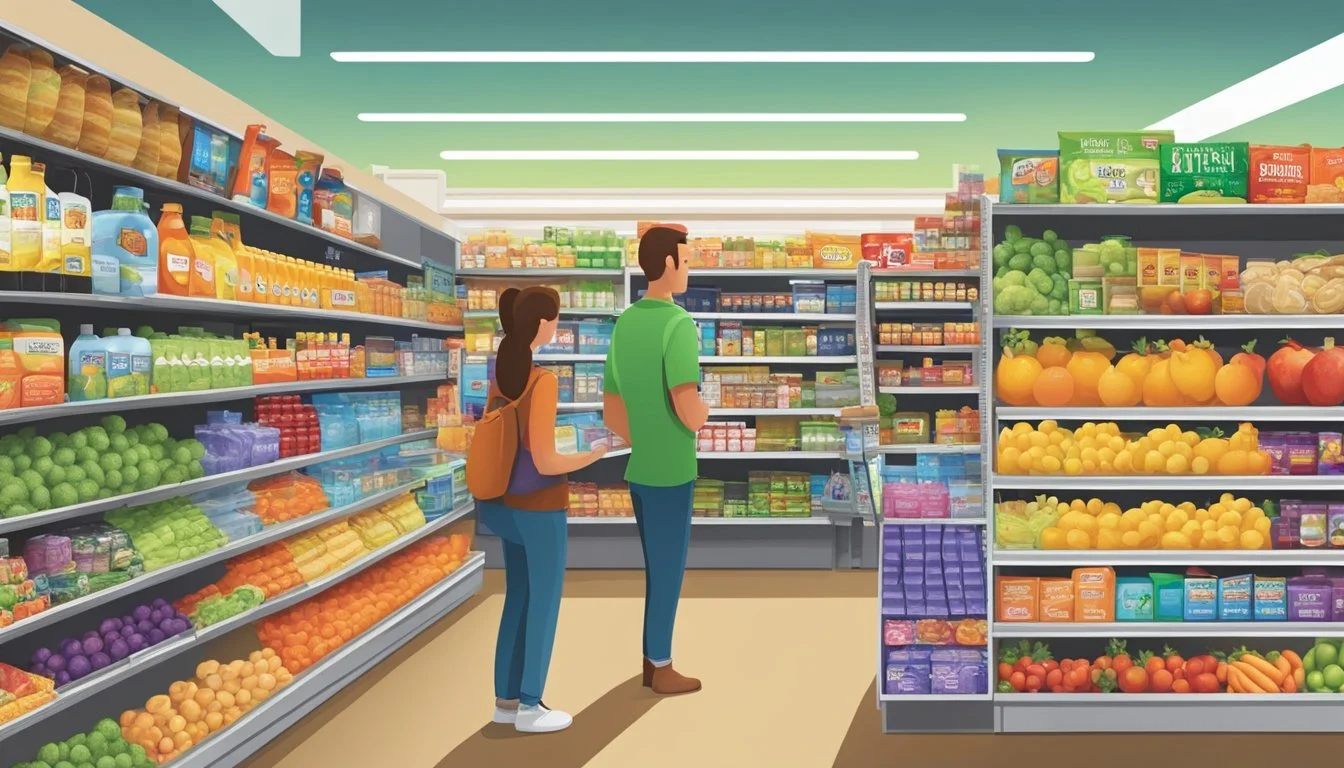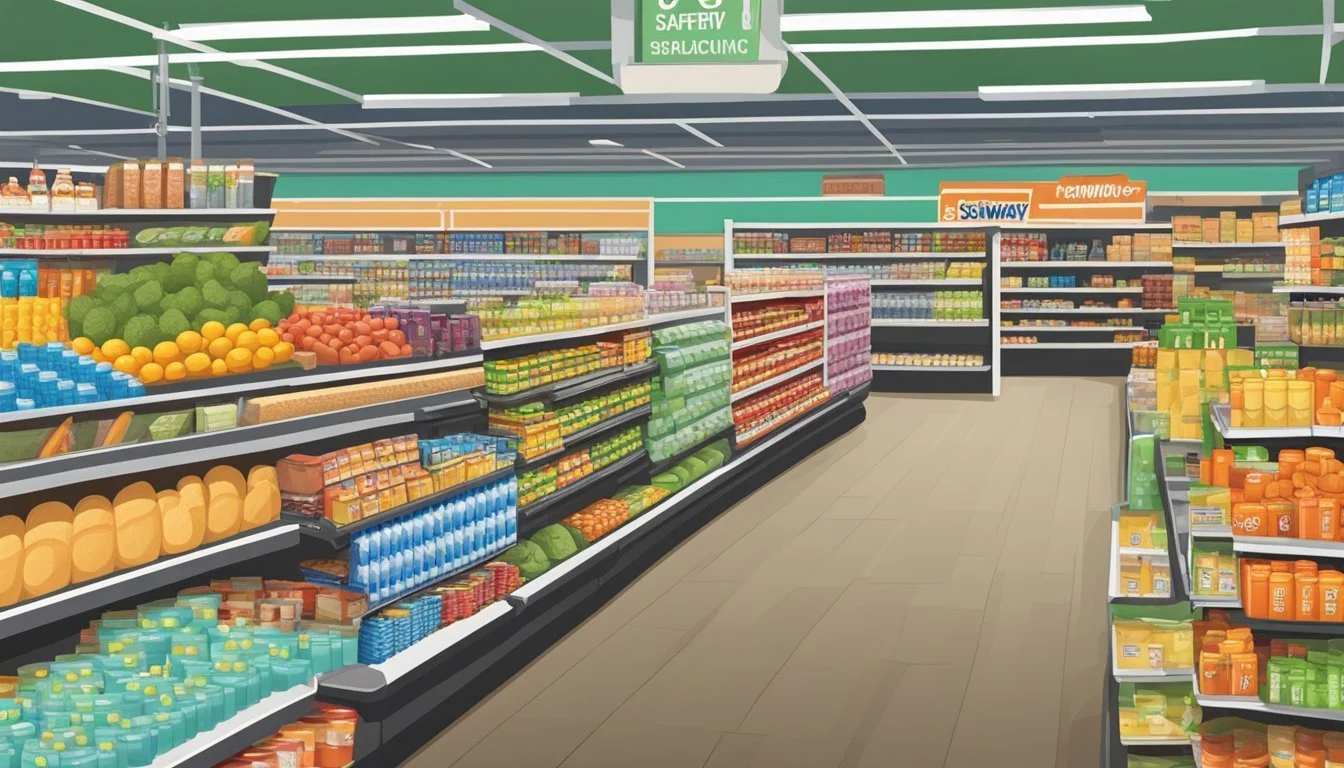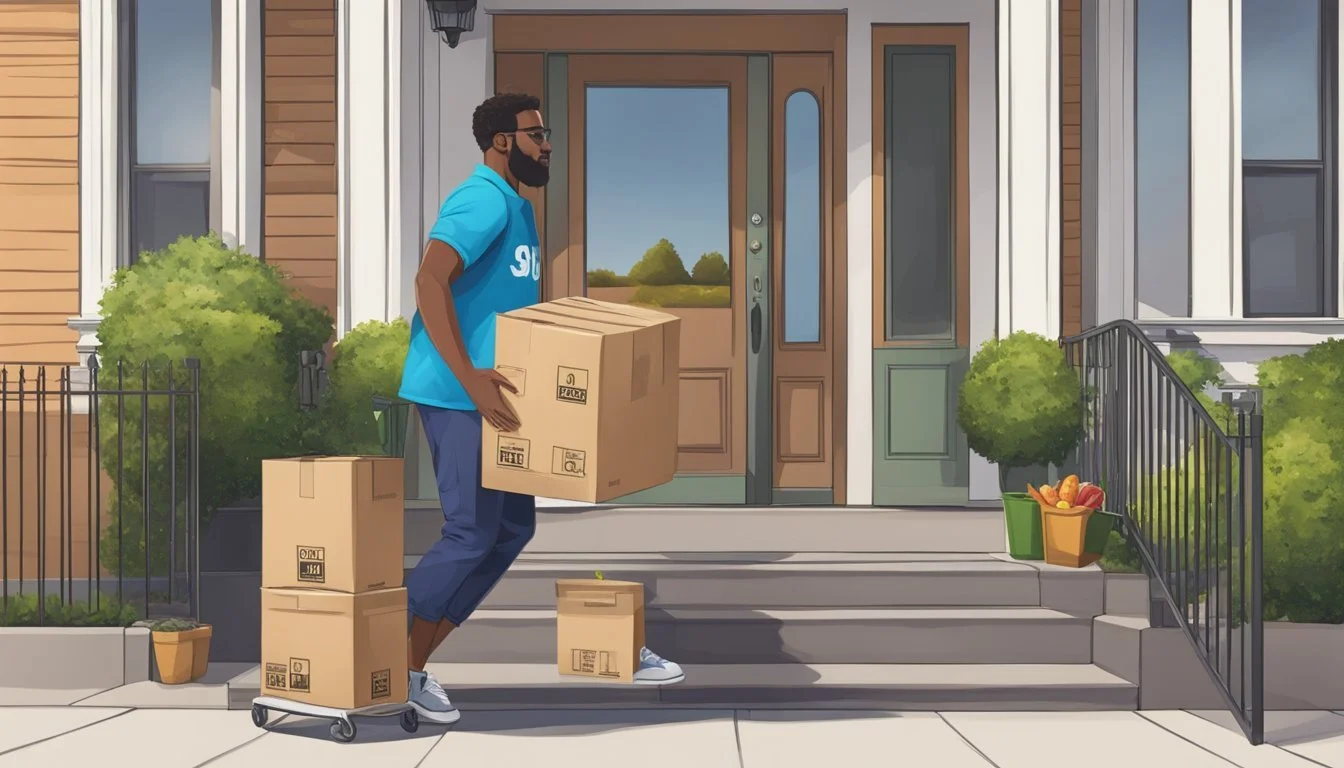Five Below vs Safeway
Comparing Prices and Selection
When comparing grocery stores, Five Below and Safeway offer distinct shopping experiences. Five Below focuses on trendy, affordable items priced at $5 or less, while Safeway is a traditional supermarket chain with a wide range of groceries and household essentials.
Safeway generally provides a more comprehensive grocery shopping experience compared to Five Below, offering fresh produce, meats, dairy, and a full selection of pantry staples. Five Below's limited grocery options typically include snacks, candies, and some packaged foods, making it better suited for quick treats or party supplies rather than weekly grocery runs.
Price-conscious shoppers may find appealing deals at both stores. Five Below's $5-and-under model can yield savings on certain items, while Safeway often provides competitive prices on groceries, especially when utilizing their loyalty program and digital coupons. The choice between the two ultimately depends on specific shopping needs and preferences.
Historical Overview and Evolution
Safeway's roots trace back to 1915 when Marion Barton Skaggs opened his first grocery store in Idaho. The company quickly expanded, pioneering innovative practices like selling produce by weight and introducing sell-by dates on products.
By the 1930s, Safeway had grown into a major grocery chain, adapting to changing consumer needs and shopping habits. The company continued to evolve, focusing on providing fresh produce, quality meats, and a wide variety of products.
Five Below, in contrast, is a much younger company. Founded in 2002 by David Schlessinger and Tom Vellios, it took a different approach to retail. The store concept focused on offering trendy products at low prices, primarily targeting teens and pre-teens.
While Safeway expanded its grocery offerings and store sizes over decades, Five Below maintained its niche in small-format stores selling non-grocery items. This fundamental difference in focus and target market has shaped their distinct evolutionary paths.
Safeway's long history in the grocery sector has allowed it to refine its operations and adapt to market trends. The company now operates over 1,300 locations across 19 states, cementing its position as a major player in the U.S. grocery industry.
Five Below's rapid growth in recent years demonstrates its success in the discount retail space. However, its evolution has been centered on expanding its product range within its core concept rather than diversifying into groceries.
Price and Value for Money
Price plays a crucial role in grocery shopping decisions. Comparing Five Below and Safeway reveals significant differences in pricing strategies and overall value for money.
Price Comparison
Five Below offers a unique pricing model, with most items priced at $5 or less. This includes a limited selection of grocery items, snacks, and beverages. Safeway, as a traditional grocery store, has a wider range of prices across its extensive product lineup.
A typical grocery basket at Five Below costs considerably less than at Safeway. However, the product selection at Five Below is limited, focusing mainly on non-perishable items and snacks.
Safeway's prices are generally higher, but the store offers a broader range of products, including fresh produce, meats, and dairy.
Cost-Saving Strategies
Both stores employ different tactics to help customers save money. Five Below's strategy revolves around its $5-and-under pricing model, making it easy for shoppers to budget.
Safeway uses various cost-saving methods:
Weekly sales circulars
Digital coupons
Loyalty program discounts
Bulk buying options
These strategies can lead to significant savings for savvy shoppers who plan their purchases around sales and promotions.
Store Brand vs National Brand
Five Below primarily stocks national brands in its limited grocery selection. This focus on well-known brands at low prices is part of its appeal.
Safeway offers a mix of national and store brands. Their store brand, Signature Select, provides cheaper alternatives to national brands across various categories. These products often offer comparable quality at lower prices, increasing value for budget-conscious shoppers.
National brands at Safeway are typically priced higher than at Five Below, reflecting the difference in their business models.
Discounts and Promotions
Five Below's main promotional strategy is its everyday low pricing. The store occasionally runs sales where items are priced even lower than $5.
Safeway offers a more diverse range of discounts and promotions:
Buy-one-get-one-free deals
Percentage discounts on specific items
Rewards points for future purchases
Seasonal sales events
Safeway's Just for U program provides personalized deals based on shopping history, potentially offering greater savings for regular customers.
Quality of Products Offered
Five Below and Safeway offer different product quality levels to cater to distinct customer segments. Safeway emphasizes higher-quality groceries, while Five Below focuses on budget-friendly items.
Produce Quality
Safeway provides a wider selection of fresh produce compared to Five Below. Their fruits and vegetables are typically fresher and of higher quality. Safeway sources produce from local farms when possible, ensuring better taste and nutritional value.
Five Below's produce options are limited. They mainly offer pre-packaged fruits and vegetables with longer shelf lives. The quality may be lower than Safeway's, but prices are more budget-friendly.
Safeway rotates seasonal produce regularly, giving customers access to in-season fruits and vegetables. They also have a dedicated organic produce section.
Organic Produce Options
Safeway offers an extensive range of organic produce. Their organic selection includes fruits, vegetables, herbs, and pre-packaged salad mixes. These products are certified organic and free from synthetic pesticides and fertilizers.
Five Below does not typically stock organic produce. Their focus is on providing affordable options rather than specialty or premium products.
Safeway's organic produce is clearly labeled and often displayed in a separate section for easy identification. They frequently run promotions on organic items to make them more accessible to budget-conscious shoppers.
Meat Quality
Safeway's meat department offers a variety of high-quality options. They stock fresh cuts of beef, pork, chicken, and seafood. Safeway also provides organic and grass-fed meat options for health-conscious customers.
Five Below does not have a fresh meat department. They may offer some pre-packaged meat products like jerky or canned meats, but the selection is limited.
Safeway's butchers can provide custom cuts and offer advice on meat preparation. They also carry premium brands and specialty meats for those seeking gourmet options.
Generic Staples
Five Below excels in offering affordable generic staples. Their selection includes basic pantry items, snacks, and household essentials at very low prices. The quality of these products is generally acceptable for their price point.
Safeway provides a wider range of generic staples under their store brand. These products offer a balance of quality and affordability. Safeway's generic items often rival name-brand products in terms of taste and quality.
Both stores stock essentials like pasta, rice, and canned goods. However, Safeway's selection is more extensive and includes healthier options like whole grain products and low-sodium alternatives.
Store Experience
Five Below and Safeway offer distinct shopping experiences tailored to their target customers. Each retailer approaches customer service, checkout efficiency, and store layout differently to meet shopper needs.
Customer Service
Five Below emphasizes a fun, vibrant atmosphere with youthful staff members. Employees are trained to be friendly and approachable, assisting customers in finding trendy items. The focus is on creating an engaging environment for bargain hunters.
Safeway takes a more traditional approach to customer service. Staff members are typically knowledgeable about grocery products and can provide recommendations. The supermarket chain often offers specialized counters with butchers, bakers, and pharmacists to provide personalized assistance.
Both stores strive to maintain clean, well-stocked shelves. However, Five Below's high-turnover inventory can sometimes lead to empty spots, while Safeway generally maintains consistent product availability.
Checkout Efficiency
Five Below utilizes a streamlined checkout process. The store's limited product range and focus on low-priced items allow for quick transactions. Self-checkout kiosks are available in some locations to further speed up the process.
Safeway offers multiple checkout options to accommodate various shopping trips. Express lanes cater to customers with fewer items, while full-service lanes handle larger grocery orders. Many Safeway stores have implemented self-checkout stations to reduce wait times during peak hours.
Both retailers have embraced mobile payment methods to enhance checkout speed. Five Below accepts popular digital wallets, while Safeway integrates its loyalty program with mobile payment options for added convenience.
Store Layout and Navigation
Five Below's stores feature a grid-like layout with clearly marked sections. Products are organized by category and price point, making it easy for shoppers to browse and discover new items. Bright signage and themed displays create an engaging shopping environment.
Safeway employs a more complex layout typical of full-service supermarkets. Produce sections are often placed near the entrance, with staple items like dairy and bread positioned toward the back. This layout encourages customers to traverse the entire store.
Five Below's compact stores allow for quick shopping trips, while Safeway's larger format accommodates a wider range of products and services. Safeway provides shopping carts and baskets, essential for grocery hauls, whereas Five Below typically offers hand baskets for its smaller items.
Product Range and Availability
Five Below and Safeway offer distinct product selections catering to different consumer needs. Their inventory ranges from everyday essentials to specialty items, with varying focuses on national brands and private labels.
Supermarket Chains Comparison
Safeway, as a traditional supermarket chain, provides a comprehensive grocery selection. Its stores stock fresh produce, meats, dairy, baked goods, and pantry staples. Safeway also carries household items, personal care products, and over-the-counter medications.
Five Below, primarily known for its discount merchandise, has expanded into groceries. Its food section focuses on snacks, beverages, and packaged goods. The store's grocery offerings are more limited compared to Safeway's full-service supermarket model.
Safeway typically has larger stores with wider aisles and more extensive product variety. Five Below stores are usually smaller, with a more compact layout and fewer grocery options.
Specialty and Seasonal Items
Safeway regularly features specialty and gourmet products in its stores. These include international foods, organic options, and locally sourced items. The chain also adapts its inventory to seasonal demands, offering holiday-specific products and summer barbecue essentials.
Five Below's specialty items are often non-food related, such as party supplies and seasonal decor. Their food selection may include limited-time snacks or trendy beverages, but the range is not as extensive as Safeway's.
Both stores stock seasonal candy and snacks, but Safeway typically offers a broader selection of holiday-themed grocery items.
National and Store Brands
Safeway carries a wide array of national brand products across all grocery categories. It also has several private label brands, including Signature Select and O Organics, which offer quality alternatives at competitive prices.
Five Below's grocery section primarily features national brands, especially in snacks and beverages. The store's focus on items priced at $5 or less limits its ability to stock premium national brands in larger sizes.
Safeway's store brands cover a broader range of products, from fresh produce to household items. Five Below's private label offerings are more limited in the grocery category, with a focus on packaged snacks and candies.
Demographic and Geographic Reach
Five Below and Safeway cater to distinct customer bases and have different geographical footprints. Their target demographics and store locations reflect their unique business models and market strategies.
Target Demographics
Five Below primarily appeals to teens, tweens, and budget-conscious shoppers seeking affordable trendy items. The store's $5-and-below price point attracts families looking for inexpensive gifts, party supplies, and seasonal decorations. Safeway, in contrast, targets a broader demographic. It serves families, working professionals, and individuals of all ages who need groceries and household essentials. Safeway's focus on fresh produce, organic options, and prepared meals also attracts health-conscious consumers and busy families seeking convenient meal solutions.
Geographical Presence
Five Below has rapidly expanded across the United States, with a strong presence in suburban shopping centers and strip malls. The chain has over 1,000 locations, primarily concentrated in the East Coast and Midwest regions. Safeway's geographical reach is more limited but densely concentrated in specific areas. The grocery chain operates around 900 stores, with a significant presence on the West Coast, particularly in California, Oregon, and Washington. Safeway also maintains a notable footprint in the Mid-Atlantic region, including Maryland and Virginia. This regional focus allows Safeway to tailor its offerings to local preferences and establish strong community ties.
Grocery Delivery and Online Shopping
Five Below and Safeway differ significantly in their approach to online shopping and grocery delivery services. These digital offerings have become increasingly important for retailers to meet evolving consumer needs.
Online Marketplace Presence
Five Below maintains a basic e-commerce website where customers can browse and purchase items for delivery or in-store pickup. The site offers a similar product selection to physical stores, focusing on affordable goods priced at $5 or less.
Safeway, in contrast, provides a more robust online shopping experience. Their website and mobile app allow customers to view weekly ads, clip digital coupons, and create shopping lists. Safeway's online platform also integrates with their loyalty program, offering personalized deals and rewards.
Grocery Delivery Options
Five Below does not offer grocery delivery services, as their product range does not include fresh food items or pantry staples. Their shipping options are limited to standard delivery for online purchases.
Safeway provides comprehensive grocery delivery services. Customers can schedule deliveries for as soon as same-day, with options for 30-minute express delivery in some areas. Safeway's delivery service includes fresh produce, meat, dairy, and household items.
Safeway offers a DeliveryPass subscription for frequent users, which can reduce per-order fees. Pricing for Safeway's delivery service is competitive, with in-store prices on many items and a $30 minimum order requirement.
Corporate Responsibility and Consumer Perception
Five Below and Safeway take different approaches to corporate responsibility, which impacts how consumers perceive and interact with these brands. Their strategies for environmental stewardship, community engagement, and building customer trust shape their reputations in the marketplace.
Environmental Impact
Five Below has implemented energy-efficient lighting and HVAC systems in its stores to reduce its carbon footprint. The company uses recycled materials in some product packaging and encourages customers to bring reusable bags. Safeway, as part of Albertsons Companies, has set ambitious sustainability goals. These include reducing plastic waste, increasing energy efficiency, and sourcing products more responsibly. Safeway has also invested in solar panels for some locations and uses fuel-efficient trucks for deliveries.
Community Involvement
Five Below supports various youth-focused charities through its corporate giving program. The company organizes volunteer events for employees and donates merchandise to local organizations. Safeway has a more extensive community outreach program. It partners with food banks to address hunger, supports breast cancer research, and funds education initiatives. Safeway's local stores often participate in neighborhood events and sponsor youth sports teams.
Customer Loyalty and Trust
Five Below cultivates a loyal following among budget-conscious shoppers and younger consumers. The company's focus on trendy, affordable products appeals to this demographic. Safeway builds customer trust through its quality assurance programs and commitment to food safety. The grocer's loyalty program offers personalized deals and fuel rewards, which many consumers value. Surveys indicate that Safeway customers appreciate the store's cleanliness and product freshness, contributing to repeat visits.
Financial Performance and Market Position
Five Below and Safeway operate in different segments of the retail market, impacting their financial performance and market positions. Five Below focuses on discount merchandise, while Safeway is a traditional grocery chain.
Five Below has shown strong revenue growth in recent years. For fiscal year 2023, the company reported net sales of $3.08 billion, a 5.9% increase from the previous year.
Safeway's financial performance is less transparent as it is now part of Albertsons Companies. However, Albertsons reported net sales of $77.65 billion for fiscal year 2022, indicating Safeway's contribution to a larger grocery conglomerate.
In terms of market position, Five Below has carved out a niche in the discount retail space. The company continues to expand, with plans to open 200 new stores in fiscal year 2024.
Safeway maintains a strong presence in the grocery market, particularly in the western United States. As part of Albertsons, it benefits from increased purchasing power and economies of scale.
Investments differ between the two companies. Five Below invests heavily in new store openings and e-commerce capabilities. Safeway, through Albertsons, focuses on store remodels and digital transformation initiatives.
Both companies face different competitive landscapes. Five Below competes with dollar stores and discount retailers, while Safeway contends with other major grocery chains and online grocery services.










